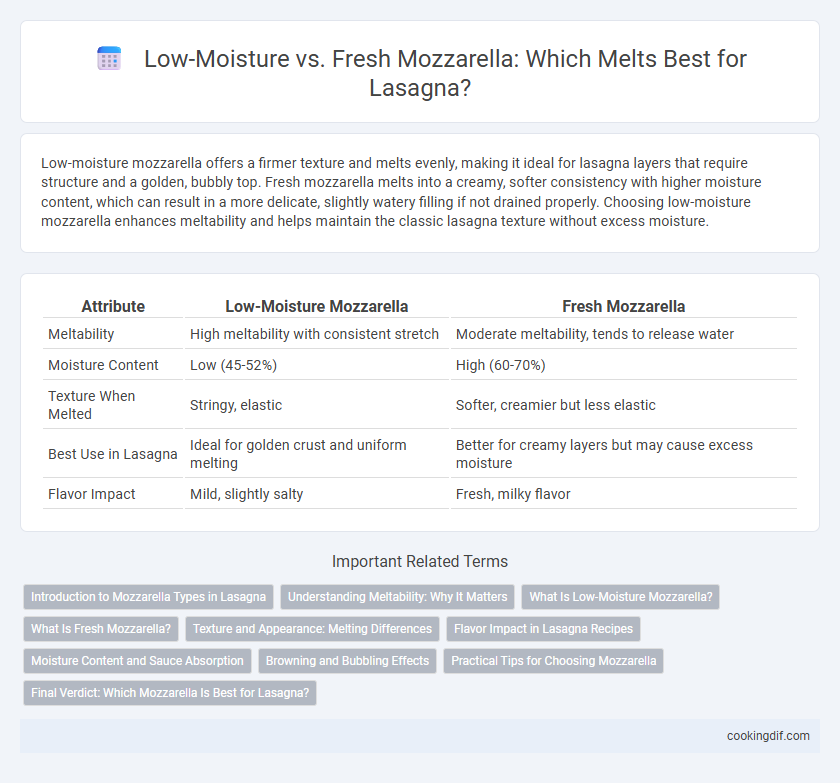Low-moisture mozzarella offers a firmer texture and melts evenly, making it ideal for lasagna layers that require structure and a golden, bubbly top. Fresh mozzarella melts into a creamy, softer consistency with higher moisture content, which can result in a more delicate, slightly watery filling if not drained properly. Choosing low-moisture mozzarella enhances meltability and helps maintain the classic lasagna texture without excess moisture.
Table of Comparison
| Attribute | Low-Moisture Mozzarella | Fresh Mozzarella |
|---|---|---|
| Meltability | High meltability with consistent stretch | Moderate meltability, tends to release water |
| Moisture Content | Low (45-52%) | High (60-70%) |
| Texture When Melted | Stringy, elastic | Softer, creamier but less elastic |
| Best Use in Lasagna | Ideal for golden crust and uniform melting | Better for creamy layers but may cause excess moisture |
| Flavor Impact | Mild, slightly salty | Fresh, milky flavor |
Introduction to Mozzarella Types in Lasagna
Low-moisture mozzarella offers a firmer texture and superior meltability, creating a gooey, stretchy layer ideal for traditional lasagna. Fresh mozzarella contains higher water content, resulting in a creamier texture but often releasing excess moisture that can make the lasagna watery. Choosing between these two impacts the dish's consistency, with low-moisture mozzarella preferred for rich, well-structured layers.
Understanding Meltability: Why It Matters
Low-moisture mozzarella offers superior meltability due to its lower water content, creating a rich, bubbly texture essential for lasagna's creamy layers. Fresh mozzarella, while flavorful and delicate, has a higher moisture content that can result in a wetter, less cohesive melt. Understanding these meltability differences ensures perfect lasagna consistency and enhances overall taste and presentation.
What Is Low-Moisture Mozzarella?
Low-moisture mozzarella is a semi-soft cheese with a lower water content compared to fresh mozzarella, resulting in a firmer texture and longer shelf life. This cheese variety melts evenly and develops a desirable stretchiness and golden-brown crust when baked in lasagna. Its reduced moisture prevents excess liquid release, making it ideal for achieving a well-structured, rich, and creamy lasagna layer.
What Is Fresh Mozzarella?
Fresh mozzarella is a soft, high-moisture cheese made from whole milk, offering a delicate texture and mild flavor ideal for lasagna. Its higher moisture content allows it to melt smoothly but can release excess liquid during baking, potentially affecting the dish's consistency. In contrast, low-moisture mozzarella, with reduced water content, melts into a firmer, stretchier layer that creates a golden, bubbly top without excess moisture.
Texture and Appearance: Melting Differences
Low-moisture mozzarella offers a firmer texture and browns more evenly on lasagna, creating a golden, bubbly crust with less water release. Fresh mozzarella melts into a creamier, softer layer with a moist, tender texture but can cause a wetter, less structured appearance due to its higher moisture content. Choosing between them affects lasagna's final mouthfeel and visual appeal, balancing meltability with texture integrity.
Flavor Impact in Lasagna Recipes
Low-moisture mozzarella offers a denser texture and a milder, slightly tangy flavor that enhances lasagna's overall richness without adding excess moisture, preserving the dish's structure. Fresh mozzarella provides a creamy, delicate taste and a high moisture content that yields a more luscious melt but can make the layers softer and may require careful excess liquid management. Choosing between low-moisture and fresh mozzarella directly influences lasagna's texture and flavor profile, with low-moisture delivering a consistent melt and fresh mozzarella contributing a fresh, milky aroma.
Moisture Content and Sauce Absorption
Low-moisture mozzarella contains approximately 45-52% moisture, resulting in a firmer texture and less water release during baking, which prevents lasagna from becoming soggy. Fresh mozzarella, with 60-72% moisture, absorbs more sauce but can lead to a wetter texture and less controlled meltability. Choosing low-moisture mozzarella enhances cheese stretch and browning, while fresh mozzarella imparts creaminess but requires careful moisture management to maintain lasagna structure.
Browning and Bubbling Effects
Low-moisture mozzarella provides superior browning and bubbling effects in lasagna due to its lower water content, resulting in a golden crust and distinct cheese bubbles. Fresh mozzarella, with higher moisture levels, melts smoothly but often creates a wetter, less browned topping that can inhibit crispness. Choosing low-moisture mozzarella enhances the lasagna's texture by promoting even heat distribution and desirable caramelization on the cheese surface.
Practical Tips for Choosing Mozzarella
Low-moisture mozzarella offers superior meltability and browning, making it ideal for lasagna layers that require a golden, bubbly finish. Fresh mozzarella, with its higher moisture content, provides a creamier texture but may release excess water, potentially thinning the sauce. Balancing these qualities, consider blending both types or draining fresh mozzarella thoroughly to achieve an optimal melt and consistency.
Final Verdict: Which Mozzarella Is Best for Lasagna?
Low-moisture mozzarella offers superior meltability and a stringy, golden-brown finish ideal for classic lasagna layers, while fresh mozzarella provides a creamier texture and delicate flavor but releases more moisture, potentially causing a soggy dish. For lasagna, low-moisture mozzarella is generally preferred due to its balanced moisture content, firmer texture, and better browning ability, ensuring a structured yet gooey melt. Choosing low-moisture mozzarella guarantees optimal cheese pull and texture, making it the best option for traditional baked lasagna recipes.
Low-moisture vs Fresh mozzarella for meltability Infographic

 cookingdif.com
cookingdif.com